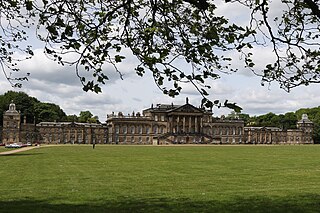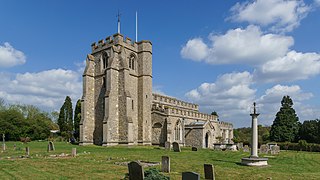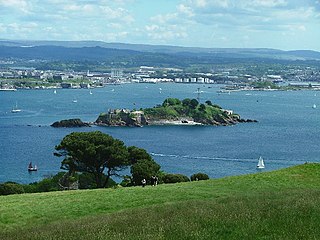
Blickling Hall is a Jacobean stately home situated in 5,000 acres of parkland in a loop of the River Bure, near the village of Blickling north of Aylsham in Norfolk, England. The mansion was built on the ruins of a Tudor building for Sir Henry Hobart from 1616 and designed by Robert Lyminge. The library at Blickling Hall contains one of the most historically significant collections of manuscripts and books in England, containing an estimated 13,000 to 14,000 volumes. The core collection was formed by Sir Richard Ellys. The property passed into the care of the National Trust in 1940.

Belton House is a Grade I listed country house in the parish of Belton near Grantham in Lincolnshire, England, built between 1685 and 1687 by Sir John Brownlow, 3rd Baronet. It is surrounded by formal gardens and a series of avenues leading to follies within a larger wooded park. Belton has been described as a compilation of all that is finest of Carolean architecture, said to be the only truly vernacular style of architecture that England had produced since the Tudor period. It is considered to be a complete example of a typical English country house; the claim has even been made that Belton's principal façade was the inspiration for the modern British motorway signs which give directions to stately homes.

Wentworth Woodhouse is a Grade I listed country house in the village of Wentworth, in the Metropolitan Borough of Rotherham in South Yorkshire, England. It is currently owned by the Wentworth Woodhouse Preservation Trust. The building has more than 300 rooms, although the precise number is unclear, with 250,000 square feet (23,000 m2) of floorspace, including 124,600 square feet (11,580 m2) of living area. It covers an area of more than 2.5 acres (1.0 ha), and is surrounded by a 180-acre (73 ha) park, and an estate of 15,000 acres (6,100 ha).

Chawton is a village and civil parish in the East Hampshire district of Hampshire, England. The village lies within the South Downs National Park and is famous as the home of Jane Austen for the last eight years of her life.

Wimpole Estate is a large estate containing Wimpole Hall, a country house located within the civil parish of Wimpole, Cambridgeshire, England, about 8+1⁄2 miles southwest of Cambridge. The house, begun in 1640, and its 3,000 acres (12 km2) of parkland and farmland are owned by the National Trust. The estate is regularly open to the public and received over 335,000 visitors in 2019. Wimpole is the largest house in Cambridgeshire.

The Bowes-Lyon family descends from George Bowes of Gibside and Streatlam Castle (1701–1760), a County Durham landowner and politician, through John Bowes, 9th Earl of Strathmore and Kinghorne, chief of the Clan Lyon. Following the marriage in 1767 of the 9th Earl to rich heiress Mary Eleanor Bowes, the family name was changed to Bowes by Act of Parliament. The 10th Earl changed the name to Lyon-Bowes and the 13th Earl, Claude, changed the order to Bowes-Lyon.

St Paul's Walden is a village about 5 miles (8 km) south of Hitchin in Hertfordshire, England. The civil parish of St Paul's Walden also includes the village of Whitwell and the hamlet of Bendish. At the 2011 Census, the population of the civil parish was 1,293.

Lydiard Park is a 260-acre (110-hectare) country park at Lydiard Tregoze, which was its former name, about 3 miles (5 km) west of central Swindon, Wiltshire, England, near Junction 16 of the M4 motorway.

Sir David Bowes-Lyon KCVO was the sixth son and last child of Claude Bowes-Lyon, 14th Earl of Strathmore and Kinghorne, and Cecilia Nina Cavendish-Bentinck, as well as their tenth and youngest child. His elder sister Lady Elizabeth Bowes-Lyon married Prince Albert, Duke of York the second son of King George V, in 1923 and became queen consort of the United Kingdom after the abdication of her husband's elder brother Edward VIII on 11 December 1936.

Cecilia Nina Bowes-Lyon, Countess of Strathmore and Kinghorne was the mother of Queen Elizabeth The Queen Mother, and maternal grandmother and godmother of Queen Elizabeth II.

A hedge maze is an outdoor garden maze or labyrinth in which the "walls" or dividers between passages are made of vertical hedges.


Adlington Hall is a country house near Adlington, Cheshire. The oldest part of the existing building, the Great Hall, was constructed between 1480 and 1505; the east wing was added in 1581. The Legh family has lived in the hall and in previous buildings on the same site since the early 14th century. After the house was occupied by Parliamentary forces during the Civil War, changes were made to the north wing, including encasing the Great Hall in brick, inserting windows, and installing an organ in the Great Hall. In the 18th century the house was inherited by Charles Legh who organised a series of major changes. These included building a new west wing, which incorporated a ballroom, and a south wing with a large portico. It is possible that Charles Legh himself was the architect for these additions. He also played a large part in planning and designing the gardens, woodland and parkland, which included a number of buildings of various types, including a bridge known as the Chinese Bridge that carried a summerhouse.

Stagenhoe is a Grade II listed stately home and surrounding gardens located in the village of St Paul's Walden in Hertfordshire. It is approximately 6 miles (10 km) south of Hitchin. It was the family seat of the Earl of Caithness. Socialite Lady Euphemia Sinclair spent her childhood there and became a friend of Queen Elizabeth the Queen Mother, whose family were neighbours.

Tyttenhanger House is a 17th-century country mansion, now converted into commercial offices, at Tyttenhanger, near St Albans, Hertfordshire. It is a Grade I listed building.

Goodnestone Park is a stately home and gardens in the southern part of the village of Goodnestone, Dover, Kent. It is approximately 7 miles (11 km) from Canterbury. The palladian house was built in 1704 by Brook Bridges, 1st Baronet. His grandson, Brook Bridges' daughter, Elizabeth, married Jane Austen's brother, and Austen visited them on the estate regularly. Goodnestone House is a Grade II* listed building, enlisted on 13 October 1952. The 15 acres (6.1 ha) gardens are considered to be amongst the finest in southeastern England. Previously the seat of the Bridges Baronets, it is now owned by their heirs, the Barons FitzWalter.

Daylesford House is a Georgian country house near Daylesford, Gloucestershire, on the north bank of the River Evenlode near the border with Oxfordshire. It is about 5 miles (8.0 km) east of Stow-on-the-Wold and 5 miles (8.0 km) west of Chipping Norton. The village of Daylesford lies nearby to the west, Adlestrop to the north, Cornwell to the east, and Kingham to the south,

Nashdom, also known as Nashdom Abbey, is a former country house and former Anglican Benedictine abbey in Burnham, Buckinghamshire, England. Designed in Neo-Georgian style by architect Edwin Lutyens, it is a Grade II* listed building. It was converted into apartments in 1997. The gardens are Grade II listed in the National Register of Historic Parks and Gardens.

South Audley Street is a major shopping street in Mayfair, London. It runs north to south from the southwest corner of Grosvenor Square to Curzon Street.

In the Western history of gardening, from the 16th to early 19th centuries, a wilderness was a highly artificial and formalized type of woodland, forming a section of a large garden. Though examples varied greatly, a typical English style was a number of geometrically-arranged compartments closed round by hedges, each compartment planted inside with relatively small trees. Between the compartments there were wide walkways or "alleys", usually of grass, sometimes of gravel. The wilderness provided shade in hot weather, and relative privacy. Though often said by garden writers at the time to be intended for meditation and reading, the wilderness was much used for walking, and often flirtation. There were few if any flowers, but there might be statues, and some seating, especially in garden rooms or salle vertes, clearings left empty. Some had other features, such as a garden maze.




















